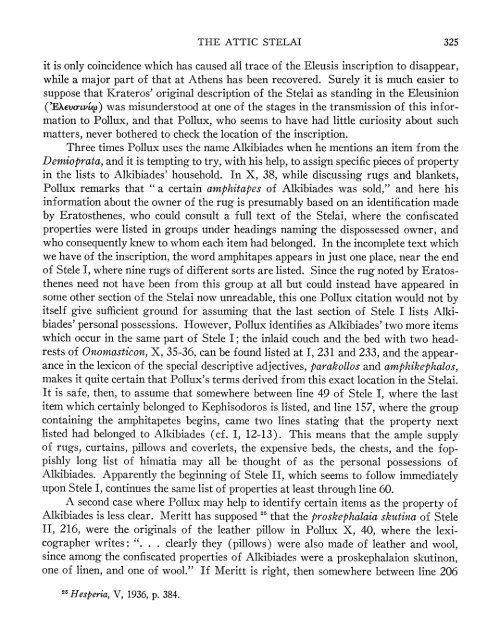the attic stelai - The American School of Classical Studies at Athens
the attic stelai - The American School of Classical Studies at Athens
the attic stelai - The American School of Classical Studies at Athens
Create successful ePaper yourself
Turn your PDF publications into a flip-book with our unique Google optimized e-Paper software.
THE ATTIC STELAI 325<br />
it is only coincidence which has caused all trace <strong>of</strong> <strong>the</strong> Eleusis inscription to disappear,<br />
while a major part <strong>of</strong> th<strong>at</strong> <strong>at</strong> A<strong>the</strong>ns has been recovered. Surely it is much easier to<br />
suppose th<strong>at</strong> Kr<strong>at</strong>eros' original description <strong>of</strong> <strong>the</strong> Stelai as standing in <strong>the</strong> Eleusinion<br />
('EXEvo-tviw) was misunderstood <strong>at</strong> one <strong>of</strong> <strong>the</strong> stages in <strong>the</strong> transmission <strong>of</strong> this inform<strong>at</strong>ion<br />
to Pollux, and th<strong>at</strong> Pollux, who seems to have had little curiosity about such<br />
m<strong>at</strong>ters, never bo<strong>the</strong>red to check <strong>the</strong> loc<strong>at</strong>ion <strong>of</strong> <strong>the</strong> inscription.<br />
Three times Pollux uses <strong>the</strong> name Alkibiades when he mentions an item from <strong>the</strong><br />
Demiopr<strong>at</strong>a, and it is tempting to try, with his help, to assign specific pieces <strong>of</strong> property<br />
in <strong>the</strong> lists to Alkibiades' household. In X, 38, while discussing rugs and blankets,<br />
Pollux remarks th<strong>at</strong> " a certain amphitapes <strong>of</strong> Alkibiades was sold," and here his<br />
inform<strong>at</strong>ion about <strong>the</strong> owner <strong>of</strong> <strong>the</strong> rug is presumably based on an identific<strong>at</strong>ion made<br />
by Er<strong>at</strong>os<strong>the</strong>nes, who could consult a full text <strong>of</strong> <strong>the</strong> Stelai, where <strong>the</strong> confisc<strong>at</strong>ed<br />
properties were listed in groups under headings naming <strong>the</strong> dispossessed owner, and<br />
who consequently knew to whom each item had belonged. In <strong>the</strong> incomplete text which<br />
we have <strong>of</strong> <strong>the</strong> inscription, <strong>the</strong> word amphitapes appears in just one place, near <strong>the</strong> end<br />
<strong>of</strong> Stele I, where nine rugs <strong>of</strong> different sorts are listed. Since <strong>the</strong> rug noted by Er<strong>at</strong>os<strong>the</strong>nes<br />
need not have been from this group <strong>at</strong> all but could instead have appeared in<br />
some o<strong>the</strong>r section <strong>of</strong> <strong>the</strong> Stelai now unreadable, this one Pollux cit<strong>at</strong>ion would not by<br />
itself give sufficient ground for assuming th<strong>at</strong> <strong>the</strong> last section <strong>of</strong> Stele I lists Alkibiades'<br />
personal possessions. However, Pollux identifies as Alkibiades' two more items<br />
which occur in <strong>the</strong> same part <strong>of</strong> Stele I; <strong>the</strong> inlaid couch and <strong>the</strong> bed with two headrests<br />
<strong>of</strong> Onomasticon, X, 35-36, can be found listed <strong>at</strong> I, 231 and 233, and <strong>the</strong> appearance<br />
in <strong>the</strong> lexicon <strong>of</strong> <strong>the</strong> special descriptive adjectives, parakollos and amphikephalos,<br />
makes it quite certain th<strong>at</strong> Pollux's terms derived from this exact loc<strong>at</strong>ion in <strong>the</strong> Stelai.<br />
It is safe, <strong>the</strong>n, to assume th<strong>at</strong> somewhere between line 49 <strong>of</strong> Stele I, where <strong>the</strong> last<br />
item which certainly belonged to Kephisodoros is listed, and line 157, where <strong>the</strong> group<br />
containing <strong>the</strong> amphitapetes begins, came two lines st<strong>at</strong>ing th<strong>at</strong> <strong>the</strong> property next<br />
listed had belonged to Alkibiades (cf. I, 12-13). This means th<strong>at</strong> <strong>the</strong> ample supply<br />
<strong>of</strong> rugs, curtains, pillows and coverlets, <strong>the</strong> expensive beds, <strong>the</strong> chests, and <strong>the</strong> foppishly<br />
long list <strong>of</strong> him<strong>at</strong>ia may all be thought <strong>of</strong> as <strong>the</strong> personal possessions <strong>of</strong><br />
Alkibiades. Apparently <strong>the</strong> beginning <strong>of</strong> Stele II, which seems to follow immedi<strong>at</strong>ely<br />
upon Stele I, continues <strong>the</strong> same list <strong>of</strong> properties <strong>at</strong> least through line 60.<br />
A second case where Pollux may help to identify certain items as <strong>the</strong> property <strong>of</strong><br />
Alkibiades is less clear. Meritt has supposed th<strong>at</strong> <strong>the</strong> proskephalaia skutina <strong>of</strong> Stele<br />
25<br />
II, 216, were <strong>the</strong> originals <strong>of</strong> <strong>the</strong> lea<strong>the</strong>r pillow in Pollux X, 40, where <strong>the</strong> lexicographer<br />
writes: ". . . clearly <strong>the</strong>y (pillows) were also made <strong>of</strong> lea<strong>the</strong>r and wool,<br />
since among <strong>the</strong> confisc<strong>at</strong>ed properties <strong>of</strong> Alkibiades were a proskephalaion skutinon,<br />
one <strong>of</strong> linen, and one <strong>of</strong> wool." If Meritt is right, <strong>the</strong>n somewhere between line 206<br />
25 Hesperia, V, 1936, p. 384.
















